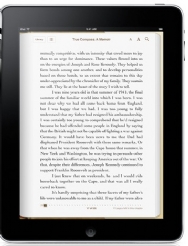Last week we discussed different methods and media that we use for reading texts, their merits and demerits, and the impact of some examples on our work. Of course, the central rivalry was between printed texts and digital ones–the book versus the computer. This dichotomy, however, comes dangerously close to assuming that for any given work, it is necessary to choose one or the other. You’re either a purist and you check out a printed and bound copy of a book, or you’re a hipster who will pick up reading on your iPhone in the exact place you left off on your iPad Mini Mega Micro Max. But I often find myself asking (in my head) those caught in this debate a question first posed by a little girl whose family was arguing about tacos:

My primary medium of reading is, to me, as close to a marriage of digital and print as I can get. I do most of my reading (of books) on my iPad through iBooks or the Kindle application. While this technology offers options wholly impossible with paper copies, I find that I try to keep my reading experience as “authentic” as possible. Both applications offer the reader the ability to choose the color of the “paper,” the size and font of the text, the color of highlighting, and where sticky notes will appear.
Personally, I like to set it at “Sepia,” a contrast setting reminiscent of old library book pages, with a standard font in a relatively small size. There’s even a page turning animation with a surprisingly responsive and accurate physics engine. In this, it seems that my aim–and to an extent, the aim of the developers as well–is to make my digital copy of a text mimic a printed copy as closely as I can, thus taking the focus off of the medium itself and returning it to the text. I adjust the medium to be the least noticeable aspect of the text, allowing me to engage directly with the words on the page.
Yet, the amazing tools that are inherent in digital texts are still literally at my fingertips; they are simply waiting in the background. If there is a word or cultural allusion I don’t understand, I can look it up without ever leaving the text and see its meaning right on the page. I can then make a note that is directly connected to its physical location on the page without ever losing my place. These features, I feel, allow the reader to become not only more deeply involved with a text, but more continuously so, as the need to constantly scan for a word or sentence or reread to pinpoint where you left off is virtually eliminated.
In this, the possibilities I find in applying the digital amenities to a close replica of a “genuine” printed text are innumerable. To me, this combination not only expands the ways in which it is possible to read, but increases the potential to engage with and understand the text to levels I would never have imagined previously.

